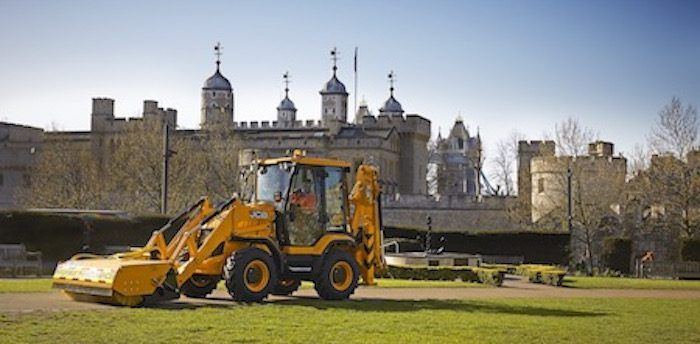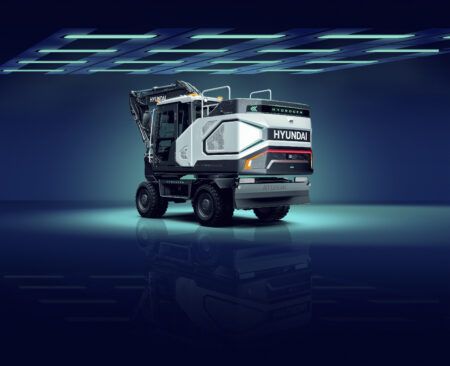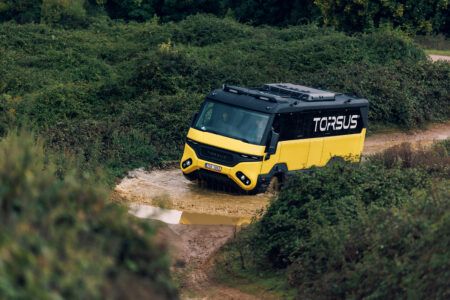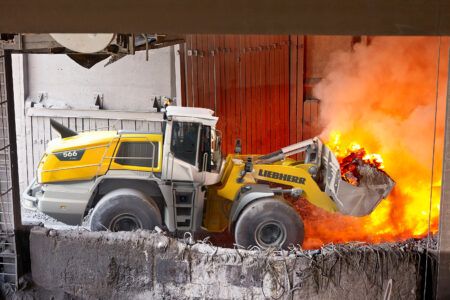A direct successor to the 2CX tool carrier and essentially
a scaled-down little brother of the 3CX backhoe loader, JCB’s new 3CX Compact tool carrier, billed by JCB as an innovative solution for the construction site of the future, looks set to perform strongly in 2017. The 3CX Compact is 35% smaller than the 3CX and aims to bring the performance of its full-sized older sibling to groundworkers and municipalities working in confined or congested building sites, particularly in urban areas such as London, where UK construction is growing most rapidly.
A distinguished pedigree
Early pioneers of the backhoe loader concept, JCB began the first UK backhoe production operation in 1953. Such has been the company’s success that nearly half of all backhoe loaders sold worldwide are JCB-made and the name JCB has entered the language as a generic term for a backhoe in the UK and also in India, where almost 75% of all backhoes sold in 2016 were JCBs. As company chairman Lord Anthony Bamford says, “It was the backhoe loader that built JCB into the company it is today and made us famous around the world.”
But rather than resting on its laurels, JCB prides itself on achieving resilient performance in the face of uncertain market conditions by producing machines fully equipped for the future, through a policy of continuous innovation. As Bamford says, “More and more of our customers have been telling us that they need a backhoe loader that is smaller, simply because they are operating in congested towns and cities and on narrow streets.”
Tim Burnhope, JCB’s chief innovation and growth officer for the UK, takes up the story of the 3CX Compact’s conception. “We spoke to many customer groups and the best description we got was, ‘We need a little big machine.’ So we said, ‘What on Earth’s a little big machine?’ And they said, ‘Well, just imagine a machine that could do pretty much the same as the large machine – maybe 10% or 20% less in terms of its duty – but you just need to shrink it down, because working environments are now tighter and more challenging.'”
Shrinking the formula
The 3CX Compact is certainly a little vehicle with big capabilities, providing 75% of the lift capacity of a 3CX. A width of just 1.9m enables it to enter areas such as gardens, parks and inner-city construction sites that have restricted entry, while a low travel height of just 2.74m allows it to access low buildings and even basements. These reduced dimensions give the 3CX Compact a turning circle of just 5.8m when in four-wheel steering (4WS) mode, which is 16% tighter than a standard backhoe, making it especially maneuverable in confined spaces and capable of performing a U-turn on single-carriageway roads. The 3CX Compact also boasts a top speed of 40km/h (25mph), which is 17% faster than the 2CX. With the option to switch to 2WS, the 3CX Compact is certainly capable of roading briskly and safely between sites without having to be mounted onto another vehicle, as with a conventional excavator.
The vehicle runs on a JCB by Kohler 74hp (55kW) diesel engine that meets US Tier 4 Final/Stage IIIB emissions standards with no need for aftertreatment, exhaust fluid or diesel particulate filters, keeping service costs down. Three-speed hydrostatic transmission eliminates the need for gearchanges and allows full power to attachments at low speed, for instance when using a sweeper. While 2WS allows safe highway travel and
4WS gives optimum on-site maneuverability, switching to
Creep Mode allows the engine to be run at high RPM to power high-flow attachments such as road planers while traveling at a speed of up to 3.5km/h (2.2mph).
The 3CX Compact’s hydraulics deliver 80 l/min flow to the front end, where parallel-lift loader arms ensure load retention in combination with JCB’s Smooth Ride System (SRS), which minimizes bounce when traversing uneven terrain. Hydraulic flow of 75 l/min is provided to the rear end, where a fixed or extended 10ft or 12ft (3 or 3.7m) dipper is available, offering a maximum dig depth of 4.33m with a shovel capacity of 0.7m3.
Practical applications
The 3CX Compact’s small footprint and all-around visibility fits the design brief of enabling easy working in congested urban areas. “It’s easy and intuitive to use, has great maneuverability, and with servo controls will suit operators of backhoes and excavators,” says Burnhope.
As well as its ability to access confined spaces, it would seem that the 3CX Compact’s real trump card is its versatility, since it embodies in a single vehicle most of the functions of a standard backhoe, a dumper, a compact wheel loader, a forklift, a motorized sweeper and of course, a mini-excavator. What’s more it can match similar sized excavators at digging while outdoing them at trenching and backfill by virtue of its front loader. It also offers a forklift function that removes the need for manual tying-on of loads and a sweeping function that does away with manual broom-pushing.
It is, says Burnhope, “a real master of all trades, a machine that is suitable for operation in road maintenance, urban construction, utility work, or any task that requires maximum performance in a compact package. There was a requirement to multitask, so we have developed a range of attachments so that it can do the job of many other machines.”
Optional hard-wearing toe plates can be added for road-stripping, as well as shovel street-pads to prevent road damage, adding to the machine’s appeal for road maintenance contractors. The loader end can be specified with either quick-hitch for customers who require versatility of attachments,
or direct mount where less frequent change-overs are needed – the latter option allows for increased tear-out forces.
As well as the choice of dipper length and extendability, other optional add-ons include limited slip differential on the axles, boom-mounted lights for night operation and cabin air-conditioning. An optional handheld hydraulic tool circuit is also available, capable of powering water pumps, breakers and disk cutters, by linking these hand tools directly to the 3CX Compact. It is a vehicle that is able to fulfill a huge variety of site demands.
Intuitive use
Another design challenge shaping the 3CX Compact was the need for operator interchangeability. “It’s very difficult to get new operators because they don’t necessarily have the skills. They can pass the test to drive the digger, but it takes time to perfect the skills, so we wanted a machine that was more intuitive,” says Burnhope. Excavator-style servo joysticks come as standard, giving increased control, while operators can switch between ISO and SAE controls, according to preference. A front visual display shows speed, gear, steering mode and any visual warnings, while a side display shows fuel, temperature, time and speed, with lighting controls on the cab’s pillar for access in failing light.
With a fatigue-reducing air-suspension seat and auxiliary 12V cabin circuit for phone-charging, not only does the 3CX Compact give operators a comfortable and intuitive ride, but it also allows project managers to monitor vehicle activity and performance through JCB’s LiveLink telematic tracking system, which also flags up servicing issues remotely and facilitates swift response in the event of theft.
Altogether the 3CX Compact comes across as a versatile contender, punching well above its 6,070kg weight, deftly maneuvering around the tight-angled construction spaces of an urban future, and simultaneously enabling JCB to maintain its history of pushing forward in backhoe leadership and innovation as it negotiates shifting markets. “Problems,” as company founder Joseph Cyril Bamford is quoted as saying, “are only
solutions in disguise.”





